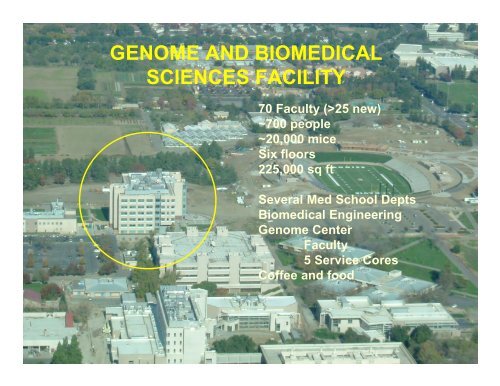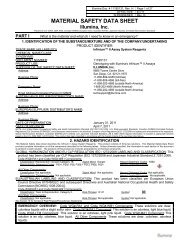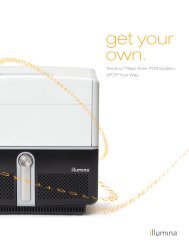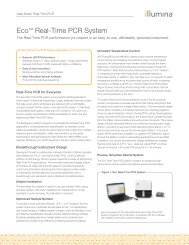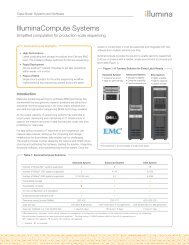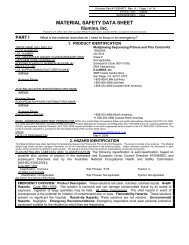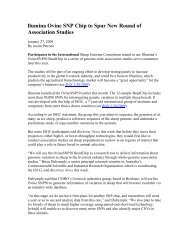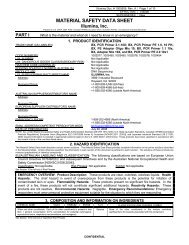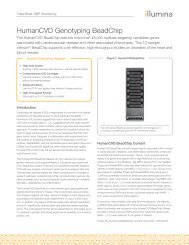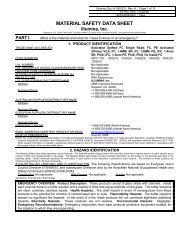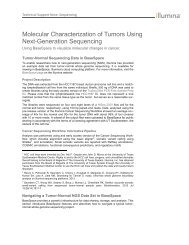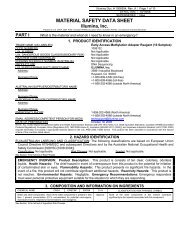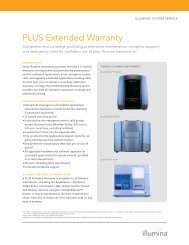GENOME AND BIOMEDICAL SCIENCES FACILITY - Illumina
GENOME AND BIOMEDICAL SCIENCES FACILITY - Illumina
GENOME AND BIOMEDICAL SCIENCES FACILITY - Illumina
Create successful ePaper yourself
Turn your PDF publications into a flip-book with our unique Google optimized e-Paper software.
<strong>GENOME</strong> <strong>AND</strong> <strong>BIOMEDICAL</strong><br />
<strong>SCIENCES</strong> <strong>FACILITY</strong><br />
70 Faculty (>25 new)<br />
~700 people<br />
~20,000 mice<br />
Six floors<br />
225,000 sq ft<br />
Several Med School Depts<br />
Biomedical Engineering<br />
Genome Center<br />
Faculty<br />
5 Service Cores<br />
Coffee and food
Using the BeadXpress to Genotype Earth’s Diversity<br />
Vertebrate Animals<br />
Mammals 5,416<br />
Birds 9,956<br />
Reptiles 8,240<br />
Amphibians 6,199<br />
Total Vertebrates 59,811<br />
Invertebrate Animals<br />
Insects 950,000<br />
Molluscs 81,000<br />
Crustaceans 40,000<br />
Corals 2,175<br />
Others 130,200<br />
Total Invertebrates 1,203,375<br />
Plants<br />
Flowering plants (angiosperms) 258,650<br />
Conifers (gymnosperms) 980<br />
Ferns and horsetails 13,025<br />
Mosses 15,000<br />
Red and green algae 9,671<br />
Total Plants 297,326<br />
Others<br />
Lichens 10,000<br />
Mushrooms 16,000<br />
Brown algae 2,849<br />
Total Others 28,849<br />
TOTAL SPECIES 1,589,361
Species Genotyped in the DNA Technologies<br />
Core using the <strong>Illumina</strong> Golden Gate Assay
Genotyping with the BeadXpress<br />
•Golden Gate assay based<br />
•Straightforward workflow<br />
•Convenient stopping, starting points<br />
•Data quality matches or exceeds solid-phase hybridization assays<br />
•Economical “project size” packages available<br />
•Flexible plexities available<br />
•Genome Studio (Bead Studio) software for data analysis
Genome Studio/Bead Studio<br />
•Intuitive Interface<br />
•Lots of ways to view, sort, export data<br />
•Easy to learn<br />
•Easy to teach
Species Genotyped in the DNA Technologies<br />
Core using the <strong>Illumina</strong> Golden Gate Assay
Canid Diversity and Conservation Group<br />
Genotyping the California Red Fox<br />
Ben Sacks, Ph.D. (& F1)<br />
•Marker analysis for population structure delimitation,<br />
population management<br />
•Population dynamics following the introduction of the<br />
Alaskan/Canadian Red Fox: displacement, hybridization,<br />
or both?
Red Fox SNPs<br />
96 selected, based on:<br />
•Linkage to STRs<br />
•Coat color<br />
•Sequenced regions (ESTs)<br />
•Sex informative<br />
•Mitochondrial (!)
Population Studies to date with STRs<br />
Native<br />
Non-native<br />
Native species does not<br />
cross the American<br />
R./Sacramento Delta
Assay Performance & Validation
Sex Determination<br />
SRY linked SNP<br />
Select non-reactive individuals<br />
X-chromosome linked SNP
Species Genotyped in the DNA Technologies<br />
Core using the <strong>Illumina</strong> Golden Gate Assay
Genotyping the California<br />
Tiger Salamander<br />
H. Bradley Shaffer, Ph.D. Jarrett Johnson<br />
•Definition of genetically-based management units<br />
•Hybridization/displacement studies with introduced<br />
barred salamander from OK, northern TX
Salamander SNPs<br />
96 selected, based on:<br />
•Linkage to STRs<br />
•Linkage to QTLs<br />
•Candidate genes:<br />
Development (Hox, Dlx, Fox)<br />
Signalling (Gnat, Wnt)
Range of CTS<br />
Hybridization Zone
California Tiger vs. Barred Salamanders<br />
California Tiger Salamander (CTS) –<br />
Ambystoma californiense<br />
Barred Tiger Salamander (BTS)<br />
– Ambystoma tigrinum mavortium<br />
Introduced by sport fishermen as bass bait
Thousands of Potential Hybrid Genotypes<br />
Genes 100%<br />
californiense<br />
Bruce Delgado<br />
Genes 100%<br />
mavortium<br />
most hybrid<br />
populations<br />
0 hybrid index 1
Investigations Utilizing SNP Analysis<br />
• Estimate the proportion of the genome affected by<br />
hybrid dysfunction or hybrid vigor and characterize<br />
variation in environment-dependent (e.g., pond type:<br />
seasonal, perennial) invasion success.<br />
• Viability selection on hybrids in the lab: place observed<br />
patterns of introgression, LD, and HWD into the context<br />
of dynamics during the initial generations of contact.<br />
• Transect sampling of 25 populations (over 100 km) to<br />
assess the stability of hybrid genotypes (over time and<br />
space using allele frequencies<br />
• Identify deviations from Mendelian and HW<br />
expectations that indicate positive or negative selection
Story so far<br />
•Ended up with approximately 68 SNPs: bonanza for<br />
amphibians (high “C” value makes STRs, AFLPs difficult)<br />
•Found SNPs linked to biologically interesting QTLs<br />
controlling timing of metamorphosis<br />
•Found SNPs in regions with significant deviations from<br />
Mendelian segregation<br />
•Transect studies identified more introduced genes than<br />
previously suspected--high resolution analyses<br />
SNPs will always provide this, but could easily<br />
work through 1200 individuals in a few weeks in<br />
our lab with the BeadXpress
Species Genotyped in the DNA Technologies<br />
Core using the <strong>Illumina</strong> Golden Gate Assay
Genetic Structure of Domestic Cats<br />
Leslie Lyons, Ph.D.
Cat SNPs<br />
384 selected, many based on:<br />
•Coat color<br />
•Blood type<br />
•X-chromosome linked (no SRY yet)<br />
•Disease related<br />
•Genome-dispersed SNPs for mapping
Microsatellites vs. SNPs in feline genetics<br />
Microsatellites evolve too quickly to resolve random breeding individuals<br />
but do give good population structure information for purebreds<br />
Microsats in purebred animals<br />
SNPs in purebred animals
Run Quality Control<br />
Index vs. Call Rate<br />
Index vs. Call Rate:<br />
Highlight Controls
Typical Index vs. Call Rate<br />
Red Fox<br />
Salamander<br />
High conversion rate in “pre-genome” organisms
Clustering Flexibility<br />
Initial clustering with all samples<br />
Plot Call Rate vs. 10% GC<br />
Select best samples<br />
Recluster based on those only<br />
Save cluster file and re-apply to all samples<br />
Options important for non-model,<br />
“pre-genome” organisms & when<br />
sample collection less than optimal<br />
More accurate calls
Acknowledgements<br />
UC Davis Researchers<br />
Ben Sacks<br />
Brad Shaffer<br />
Jarret Johnson<br />
Leslie Lyons<br />
Jennifer Kurushima<br />
UC Davis Colleagues<br />
Vanessa Rashbrook<br />
Heather Witt<br />
Marc Crepeau<br />
<strong>Illumina</strong><br />
Regina Nagle<br />
Sam Stingley<br />
Sarah Parsons


